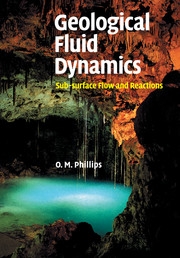1 - Introduction
Published online by Cambridge University Press: 25 January 2011
Summary
The relatively new scientific field of Geological Fluid Mechanics is concerned with applying the principles of fluid mechanics to the geological sciences. It is characterized by close interaction between carefully conceived laboratory measurements on geological flows and theoretical analyses that interpret the results in terms of basic physical principles. It was given this name by Herbert Huppert in Cambridge, one of its leading practitioners in a company that includes Andrew Woods, also in Cambridge, George Veronis at Yale, Stewart Turner at ANU, Canberra, and many other technically powerful and imaginative scientists. This present book concentrates on the part of Geological Fluid Mechanics that involves the flow of passive and reacting fluids through porous or fractured geological media. In our planet, both hot and cold aqueous fluids have flowed or seeped through sand and fractured rocks for eons, modifying their composition by dissolution, chemical reaction and deposition. Great crystalline formations and mineral deposits were formed by nature during that time and modifications continue naturally. The study of these processes was always an interesting intellectual challenge, but one of no particular urgency. Yet within a couple of lifetimes the pace of change has exploded as a result of human activity.
The contamination of our aquifers, and in turn the rivers and estuaries into which the groundwater flows, is the result of both deliberate and inadvertent injection of a variety of human, agricultural and industrial wastes, but our knowledge of the extent of these changes is meager.
Information
- Type
- Chapter
- Information
- Geological Fluid DynamicsSub-surface Flow and Reactions, pp. 1 - 5Publisher: Cambridge University PressPrint publication year: 2009
Accessibility standard: Unknown
Why this information is here
This section outlines the accessibility features of this content - including support for screen readers, full keyboard navigation and high-contrast display options. This may not be relevant for you.Accessibility Information
- 2
- Cited by
